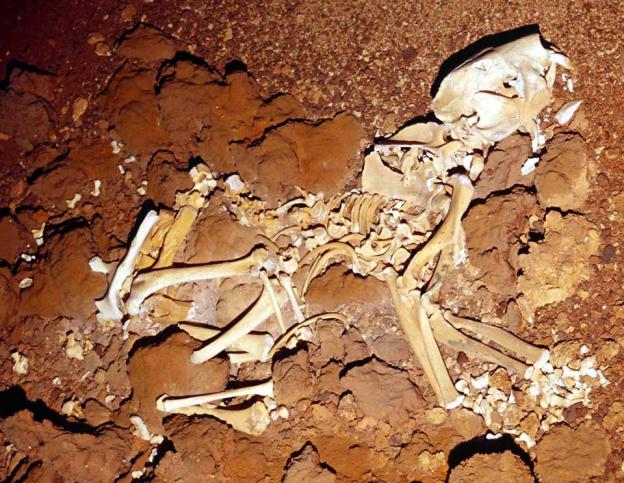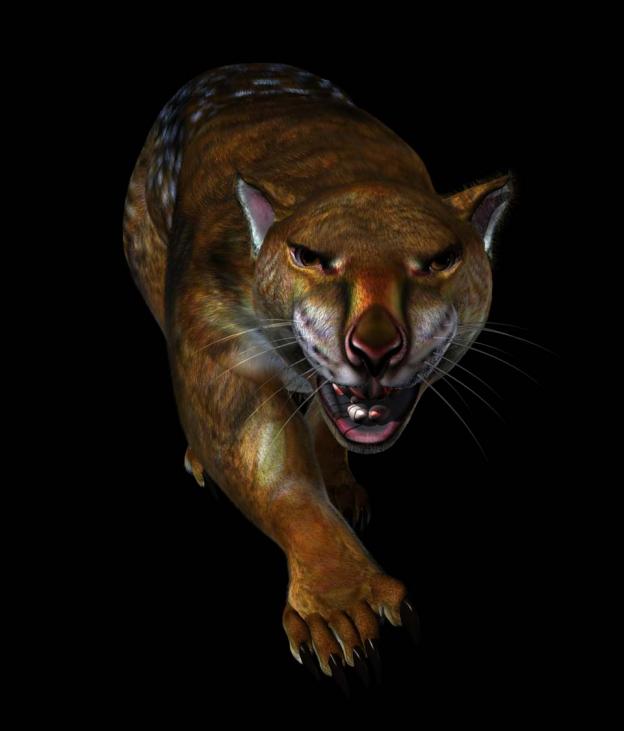The most famous discovery of our first expedition to the Nullarbor caves was an almost complete skeleton of the Thylacoleo carnifex or marsupial lion. For the first time scientists were able to accurately gauge the size of this formidable predator. Imagine a beast the size of a leopard, but built like a bear. Capable of sitting up like a kangaroo, possessing huge claws for ripping and disembowelling, able to climb trees with the use of an opposable thumb and with a bite more powerful than any known mammal. This was a beast you would not want to meet on a dark night! A complete skeleton can reveal so much.

The Thylacoleo carnifex is believed to have evolved from a plant eating species of wombat or possum. It is 1.5m long (head-tail) and 75cm tall at the shoulder. The limb proportions of Thylacoleo carnifex suggest that it was cursorial (adapted for running), but not swift. It also possessed a pseudo-opposable thumb which suggests it may have been partly scansorial (adapted for climbing). Thylacoleo carnifex was widely distributed over Australia during the Pleistocene era, and remains have been found in all states. It's distinguishing feature is it's dentition, which is unlike that of any other mammalian carnivore. The Thylacoleo had no canines in the lower jaw, and only small, non-functional canines in the upper jaw. The inner incisors however were larger in relation to the other teeth and resembled the incisors of a rodent. The molars or back teeth, usually used for grinding plant material, and all but one of the premolars were very small. The third premolar however, had evolved into an enormous bolt-like cutting device, enabling the Thylacoleo to slice through flesh with ease. Thylacoleo would have primarily fed on flesh as they did not possess teeth modifications to assist with bone cracking.
Due to the location of discovered fossils, the habitat of Thylacoleo may have been dry, open forest areas. Its predominantly carnivorous diet is due to the fact Thylacoleo had no grinding teeth to process plant matter and therefore could not incorporate much plant food into its diet. An adult Thylacoleo would have been about as large as a jaguar, with a very broad head and immensely powerful jaws. The bite force of Thylacoleo has been estimated to be comparable to that of the considerably larger male African lion. The Thylacoleo may have been an ambush predator or scavenger, possessing a huge thumb claw that may have been used to disembowel its prey. It is believed Thylacoleo may have fallen into the dark recesses of the Nullarbor caves purely by accident, perhaps whilst hunting or lured by the scent of food.

Other species discovered in the cave include the short-faced giant kangaroo known as the Procoptodon goliah. This was the largest of the Pleistocene Kangaroos, weighing as much as 200kg and growing to up to 3m tall. Procoptodons lived in large mobs, with the strongest and toughest male as the leader – travelling as a group offered protection from predators such as humans and the Thylacoleo. The Procoptodon goliah has been found throughout Australia, with the exception of Tasmania in predominantly arid to semi-arid environments. Like other marsupials, Procoptodon goliah would have given birth to their young which would have developed to maturity in their pouch, just like the modern kangaroo. The Procoptodons possessed a complex set of teeth, and were considered browsers rather than grazers. They were able to chew tougher stems and leaves that grew in both arid and semi-arid environments. Without being limited to only one type of vegetation, Procoptodons allowed for some variety in their diet. The Procoptodons also possessed a fourth toe, which appeared as a single huge digit resembling a hoof. This structural adaptation would have helped the Procoptodon to quickly and efficiently travel, as well as to escape from predators. They were also capable of reaching over their heads to grab leaves off trees for food, using their tail and hind legs as support props. Their short face and deep skull supported strong muscles for chewing food, giving them a powerful advantage in the ability to eat tough stems and leaves.
Several theories attempt to account for the extinction of megafauna. One prominent theory is climate change, brought about by glacial ice ages which increased aridity and placed extreme pressure on the environment, and as a result, the large megafauna species could not cope. Another supported theory is that they were decimated after the arrival of humans, principally caused by changing landscapes due to fire-stick farming practised by Indigenous Australians.